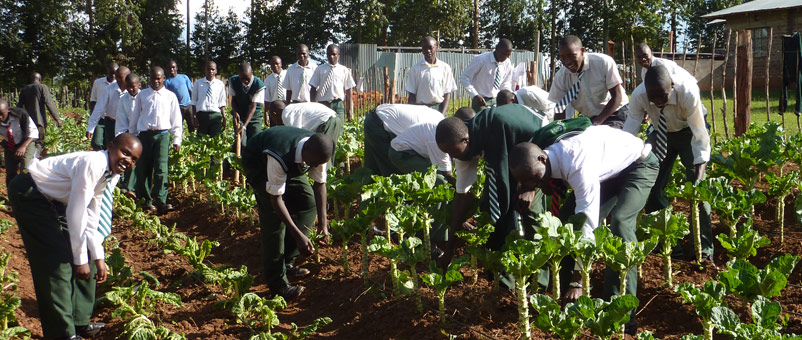This month, we asked members of the Young Professionals for Agricultural Development (YPARD) network to explore which agricultural technologies can have the biggest impact in their home countries and regions. The four respondents – each from a different continent around the world – used the brand new online model, “Agritech Toolbox”, produced by the International Food Policy Research Institute (IFPRI), which allows users to interact with original data showing expected yields of rice, wheat and maize between now and 2050 under various climate change scenarios from the use of 11 different agricultural technologies. Here is what they discovered…
 “Eastern Europe and Central Asia has been recognized by the World Bank and FAO as having large untapped production potential. In fact, countries such as Ukraine, Russia and Kazakhstan could potentially meet almost half of the world’s grain export needs in the near future.
“Eastern Europe and Central Asia has been recognized by the World Bank and FAO as having large untapped production potential. In fact, countries such as Ukraine, Russia and Kazakhstan could potentially meet almost half of the world’s grain export needs in the near future.
Current meteorological data indicates that the climate in the region becomes increasingly wet and warm, so I have chosen this parameter for the Agritech Toolbox modelling.
I discovered that wheat yields in Ukraine and Russia could increase up to 31%, and up to 39% in Kazakhstan, if no-till technology is adopted. Currently, all three countries use intensive large scale farming systems that obviously includes tilling. Up to now only a few small-to-medium sized enterprises are using no-till technology. In Azerbaijan, no-till technology could have stunning results – increasing wheat yields by 200% by 2050!
According to the tool, precision agriculture could have an even bigger impact on wheat yields, promising increases of 50%. However, this technology faces several challenges, as it requires special equipment and a lot of data management. We should also consider that changing the farmers’ practices and stimulating their willingness to undertake special training is a big challenge. Agriculture relied on cheap labour in most of the countries in Eastern Europe and Central Asia following years of communism. Therefore, bringing technology and innovation to the farm does require some time.
I definitely enjoyed using this tool. Since it is built on a large and reliable data, policymakers may find the tool useful to develop future scenarios, incorporating long-term effects of climate change on food production on a country level. Moreover, the Agritech Toolbox could also be used for regional and national workshops for various groups of stakeholders.”
Kristina Kuznetsova, Ukraine
 “Malnutrition rates in Nepal are among the highest in the world; 41% of children under 5 are stunted and 29% are underweight. Our food security status is so tragic; if policymakers do not judiciously select the best technologies to invest and encourage the condition will only get worse.
“Malnutrition rates in Nepal are among the highest in the world; 41% of children under 5 are stunted and 29% are underweight. Our food security status is so tragic; if policymakers do not judiciously select the best technologies to invest and encourage the condition will only get worse.
Rice, maize and wheat are major staple crops in our region. In Nepal, rice alone covers 43.02% of total cereal production in terms of area cultivated, followed by maize (26.05%) and wheat (22.06%).
This toolbox shows there is huge potential for these crops; there could be a yield increase of up to 91.4% for wheat and a 35.7% yield increase for maize using no-till technology. No-till technology is already being practiced in our region and is giving satisfactory results. Other technologies like Integrated Pest Management (IPM), use of drought tolerance varieties, different irrigation systems and crop protection from diseases, insects and weeds are also popular and in use but are limited within progressive farmers. Limited resources, lack of technical knowhow, unavailability of resources in time and in need and geographical condition of the country are barriers that are stopping farmers using agricultural technologies.
Recently the Nepalese government unveiled its National Budget for the fiscal year 2014/15 and the commercialization of agriculture was a major priority. 23.28 billion Nepalese rupees has been allocated for agriculture and 18.10 billion allocated for irrigation. Subsidies and rebate in purchasing of farm machineries is also allocated. As the Nepalese government is trying its best to increase the agricultural production and meet the national demand of the food it is worthwhile for them to go through this toolbox as it reflects major technologies being practiced in country and their expected yield in interaction with climate and irrigation.
Judicious use of available resources along with different technologies cited could build good impact in increasing yield of our region. This toolbox is really helpful and has set new milestone for agriculture activists.”
Anish Sapkota, Nepal
As an animal scientist working over seven years in small-scale farming projects, I believe this toolbox is very useful for governmental and non-governmental agricultural and extension agents to predict the best combinations of technologies that should be used in projects to support smallholders. In addition to traditional problems such as the lack of adequate agricultural extension services, weak levels of organization and difficulties to access the market, smallholder farmers in Latin America are facing new challenges such as climate change and water scarcity, that have a strong impact in their production and productivity. So, we need to create or reevaluate technologies with the farmers, considering their beliefs, priorities and knowledge.
Through the use of Agritech Toolbox, I learned about the crucial impact of water management in agricultural yield. Simple, cheap, but valuable technologies such as irrigation and water harvesting, which are currently used in the Andean region, allows very important yield increases. But, in order to encourage farmers to have a wider use of these technologies, countries such as Peru must invest more in education than in subsidized programs. Unfortunately there is not a culture of water care and the water´s payment system doesn´t provide many benefits to users who care about the environment.
Finally, I wish all this new knowledge will be available in my maternal tongue, Spanish, so, more professionals could make good use of it.
Natalia Lozano, Peru
 The Agritech toolbox really demonstrates that the different technologies used to fight food insecurity must be based on the region. The technology that is going to work for Africa might not work perfectly at Asia or Latin America and vice versa due to various factors e.g. climatic factors like rainfall and water, light, temperature, relative humidity, air, and wind. For example, in my own country, Nigeria, integrated soil fertility management could increase maize yields by over 30%, but in South Asia the impact would only be a 2.6% yield increase.
The Agritech toolbox really demonstrates that the different technologies used to fight food insecurity must be based on the region. The technology that is going to work for Africa might not work perfectly at Asia or Latin America and vice versa due to various factors e.g. climatic factors like rainfall and water, light, temperature, relative humidity, air, and wind. For example, in my own country, Nigeria, integrated soil fertility management could increase maize yields by over 30%, but in South Asia the impact would only be a 2.6% yield increase.
This tool and accompanying report has also demonstrated that use of combined technologies for a maximum impact will go a long way in Africa. For example, In Sub-Saharan Africa, no-till increases maize yields by more than 100 percent when combined with irrigation.
However, farmers need to be enlightened about the usage of these technologies; the government should assist them by bringing in experts from various parts of the regions to come and share their knowledge and teach them how to improve their farming skills.
John Oluwafemi, Nigeria






